
|
The Perfect Holiday Present: The Natural History Gift of the Month Club by Richard L. Howey, Wyoming, USA |
Considering the monstrous economic catastrophe that the pathologically greedy have caused to descend upon the rest of us, I propose that we produce our own gifts, as much as possible from items we already have on hand, and let the wealthy save the economy by mandating that anyone with a net income of over $250,000 buy a subscription to The Natural History Gift of the Month Club–no exceptions! We live in a series of social, economic, and cultural contexts which are egregiously unbalanced. There are millions of people who starve to death each year, while others accrue fortunes of hundreds of millions, even billions of dollars, buy houses and yachts that cost tens of millions of dollars, own seven houses–one for each day of the week, I guess- and proclaim that they are righteous Christians, Muslims, Hindus, or Buddhists. In the meantime, there are thousands of people in Haiti, who eat “cookies” made of mud and straw just to fill their bellies and make the excruciating pain of hunger diminish a bit.
So, to help balance things out a bit, I propose the following fee schedule.
Oh, yes, I should explain that not only will subscribers, both voluntary and mandatory ones, receive a gift each month of the year, but that the gifts will vary widely depending upon the person who contributes them.
FEE SCHEDULE
1) Persons and families with up to 2 children with a net income of less than $50,000–FREE. If you have more than 2 children, you need to control your lust and stop overpopulating the planet–you don’t get anything.
2) Persons and families (remember 2 children or less) with a net income of less than $100,000 pay a subscription rate of $120 per year. Hey, that’s only $10 a month.
3) $250,000–subscription $2,500. That’s only 1%.
4) $500,000–subscription $5,000
5) For those with net incomes of a $1 million or more, the religious model of tithing will be followed. In other words, those earning $1 million will have a subscription rate of $100,000, those earning $2 million will pay $200,000, etc.
Now there are 3 major issues we need to consider.
1) Who will make and distribute the gifts for the club?
2) How will they be compensated for their time, expertise, and materials?
3) What will be done with the large surpluses of money which will accrue? Clearly, investing it in the stock market doesn’t seem to be a very good option at this time.
Items #1 and #2
Clearly, we’re going to have to have large numbers of amateur microscopists and natural history buffs involved, but an incentive of $25 to $100 per month per set should interest a lot of people. So, if you produce 10 good sets a month at $25, for the year you’ll receive $3,000. If you produce 10 exceptional sets a month at $100, you’ll receive $12,000 for the year. However, we don’t want to encourage greed, so the maximum that any individual can earn per year from the club will be $57,600 for 48 first-rate sets per month. To keep the process current in terms of the economy, there will be an annual adjustment for inflation.
Each person who provides materials for the club will also be expected to subscribe to one set for the year and provide reports on the quality of the gifts they receive. Such monitoring is essential to quality control and to ranking the value of the material. This may sound like an extra burden, but remember, there are a lot of millionaires in the world. Also remember that if you only earn a few thousands dollars a year, for most of us, that’s not pocket change and there are far, far too many people on this planet who earn less than a dollar a day.
The Gifts
Being the curmudgeon that I am, my first inclination was to suggest that the very best material be sent to those who earn less than $50,000 and that low-grade junk be sent to the millionaires. On reflection, however, my conscience got the better of me and I decided that integrity demands that we should strive to maintain high standards at all levels to promote the interest of as many people as possible in microscopy and natural history and so there shall only be four grades of gifts; good, very good, fine, and exceptional–the exceptional gifts going to the poorest and the good gifts going to the millionaires. This latter group will probably just throw them away anyway and get their lawyers to write long, tedious letter to members of Congress about taxation without representation which would be ironic, since many of those who are wealthiest have representation without taxation, but then irony never was one of politicians’ strong points.
To maximize coordination and minimize confusion (or vice versa) the Central Committee of the Global Imperial Microscopical Society will stipulate a category for each month as follows:
January
Crystals
Although it is not required that the producer provide a slide, this is an opportunity for the slide maker to shine. A slide of bath salts or ordinary table salt is certainly impressive in its own way, but if you want a dazzler, try something like Ascorbic acid (Vitamin C) or Orange G with polarized light.

Crystals of Bath Salts

Ascorbic Acid crystals under polarized light

Orange G crystals under polarized light
Another option is to provide a micro-mount of mineral crystals, some of which come as close to perfection in the mineral world as one can imagine. These, of course, are to be viewed with a stereo-dissecting microscope and can be most satisfying.

A micro-mount of Kutnohorite from Tuscany, Italy
On one occasion, I let a bottle of red wine sit far too long, after we had drunk most of it, and I discovered at the bottom an interesting looking sediment. I did what any self-respecting microscopist would do and put the sediment into a watch glass for examination and discovered some lovely crystals.

Wine crystals. Note that they are an accumulation of blades of smaller crystals.
Another splendid gift can be made by placing a tiny, thin piece of copper on a slide. You can either shave it from a piece of copper wire or use a fragment of copper foil. Then add a drop of Silver nitrate. (CAUTION: Caustic!) and in moments a wonderful set of arboraceous crystals will begin to form producing a series of microscopic “trees”.

February
Diatoms, Radiolaria, or Forams
If you don’t happen to have any on hand, you can order small vials of them from a biological supply house and a single vial will provide you with enough specimens to produce dozens of slides. If you have the patience and steadiness of hand, you can create a beautiful arrangement of the specimens in patterns following the example made popular by 19th Century microscopists.


An elegant radiolarian

A lovely example of arranged diatoms
With diatoms, radiolaria, and a few types of forams one can make slides which can be viewed with transmitted light using a compound microscope. However, one can also make opaque mounts using paleo slides and get nice results. For most forams, this type of mount is preferable, but I have also found that certain radiolaria can be mounted in this fashion to advantage showing off the internal structure of certain spherical forms which possess internal struts.

An intact spherical radiolarian
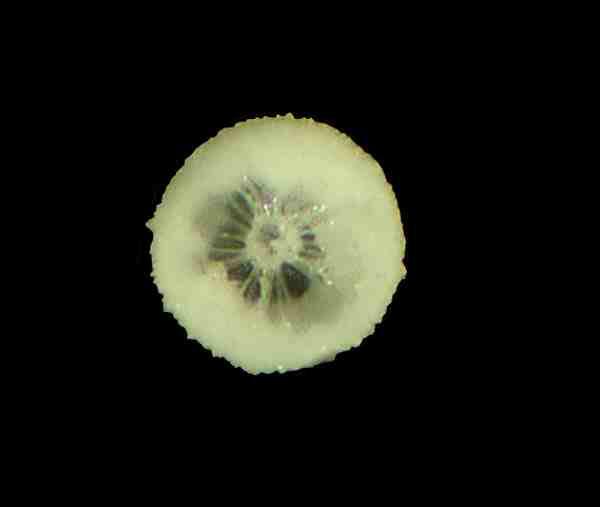
The same species cut open to reveal the internal struts
March
Plant Parts or Sections
If you have a microtome, then you can do all kinds of dazzling things by way of producing plant sections and you can also produce miniature works of art by means of multiple staining.

A splendid example of section of a stem
(This image is from a slide prepared by Patrick Everest of Humulus lupulus (Hop) and stained with Safranin and Alcian Blue. Mr. Everest kindly sent me this and several other slides which were winners of an E.C. Marson Slide Award.)
Fortunately, you don’t need a microtome to produce some very nice sections. Professional microtomes are expensive, require special training and procedures, and the blades can be very dangerous if dropped. However, for a relatively modest price, one can acquire a hand microtome which can be quite useful. However, with a very sharp scalpel or razor blade, one can often obtain quite satisfactory sections without the bother of preparing even a hand microtome. A variety of plant structures show up quite strikingly under polarized light.
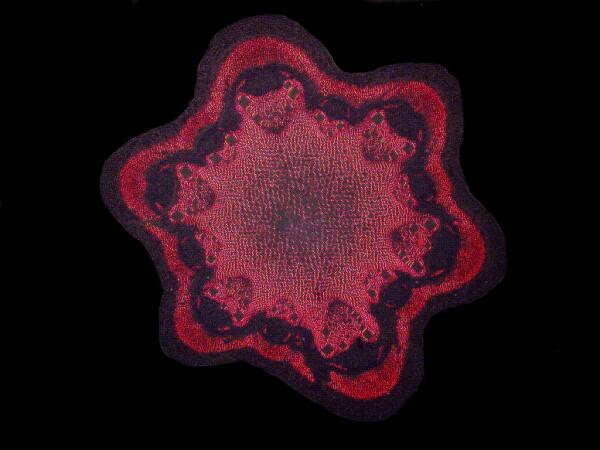
This is the same stem section as above, this time viewed with polarized light
A number of plants have crystals in their tissues and these too provide a nice display under polarized light
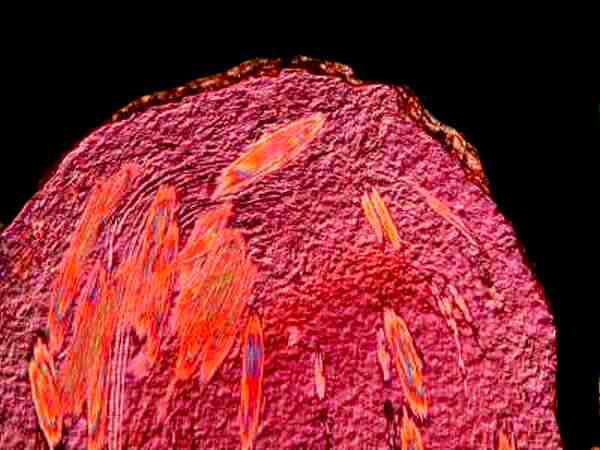
This shows the crystals in a Fuchsia and was prepared by hand sectioning.
April
Desmids or Other Micro-Algae
Desmids are glorious organisms. They have wonderful shapes and lovely rich green chloroplasts. Here is a crescent -shaped specimen called Closterium.
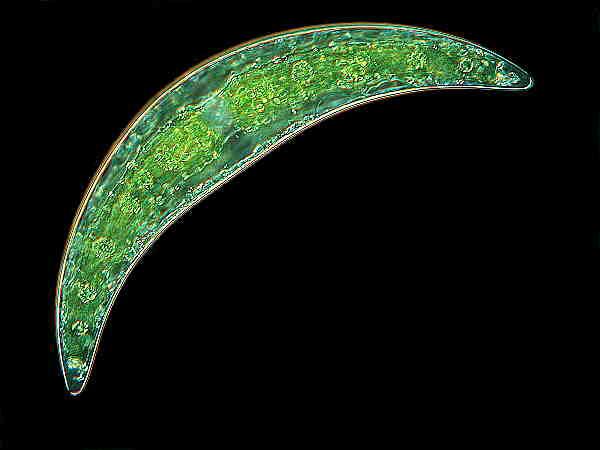
At this time of the year, desmids begin to appear in ponds and streams and can sometimes be found in great numbers growing on rocks and aquatic vegetation. Another splendid example is Micrasterias.
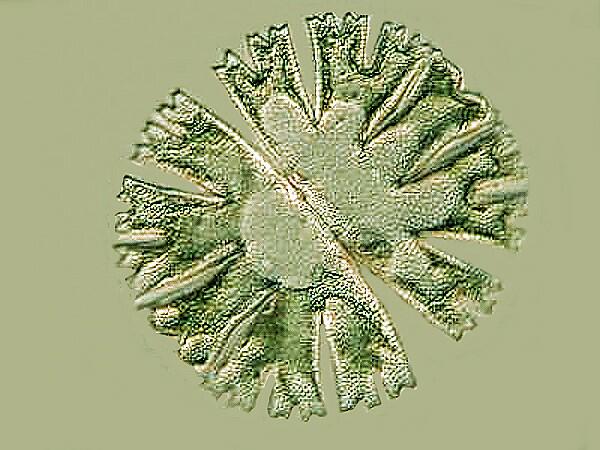
If, however, you live in an environment like I do where in April there is still ice on the ponds and streams and you didn’t preserve any specimens last summer when they were abundant, then you may once again have to turn to a biological supply house. Again, a small vial will provide you with a generous amount of material for making slides.
If, however, you do have some preserved aquatic vegetation the chances are very good that you will find some good specimens of micro-algae with which you can make very interesting slides. An intriguing mount can be made using Nostoc which is a colonial alga and forms roughly spherical balls which can be 3 inches or more in diameter. One can slice off a small portion, place it on a slide and squash it under a cover glass. This will reveal the filaments within the gelatinous matrix that comprises the colony.

May
Sphagnum Moss or Lichens
Sphagnum moss is marvelous stuff. It is often found in abundance along the edges of lakes and ponds and serves as a kind of micro community center where some of the guests end up being food. Here one can find protozoa, rotifers, tardigrades, ostracods, cyclops, desmids, and many other micro-critters. However, what we’re interested in is the sphagnum leaves themselves. One of the best ways to prepare them is to allow them to sit in the pond water for a couple of weeks and gradually decay. Individual leaves can be selected and mounted and if you have an artistic bent you can even make arrangements of them. The cell structure shows up nicely and if the angle of illumination is just right, the leaves can manifest iridescence. If you are in a hurry, you can treat them with hydrogen peroxide or a bit of household bleach to remove some of the contents of the cells.
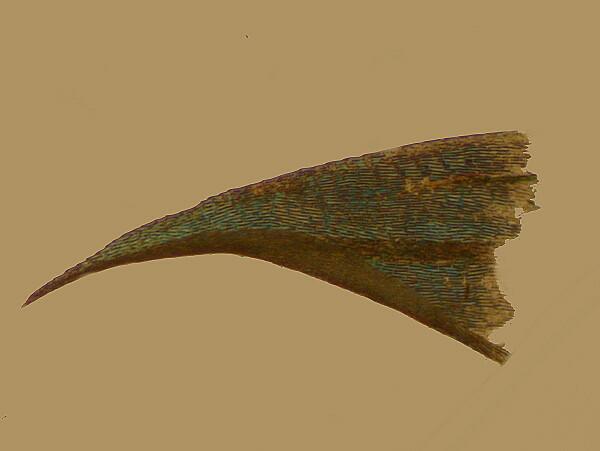
Lichens can be found at almost any time of the year and in highly unlikely places–on rocks, wood, buildings, and I even found some growing on some old asphalt roofing. They come in a variety of colors--grey, green orange, brown, yellow, near-black–and are a symbiotic entity consisting of a fungus and an organism capable of photosynthesis, usually either a cyanobacterium or an alga.
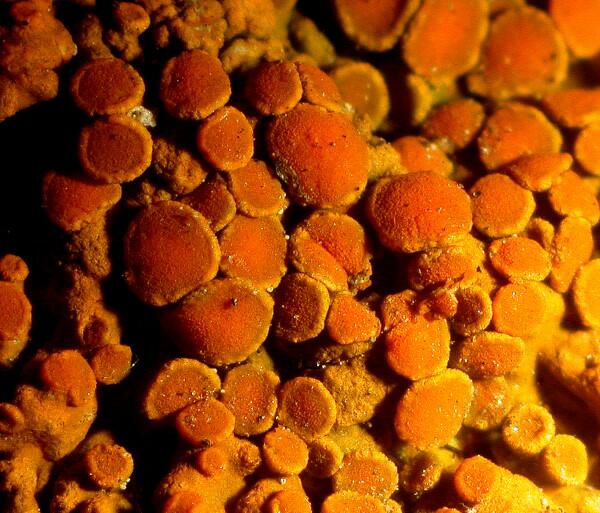
One of the reasons that these organisms are of such interest is that they are life forms which can exist under conditions and in places where we would not expect organisms to be able to function. Lichens survive in extremely arid environments and can cope with high temperatures, intense solar radiation, and sub-zero temperatures as well. For these reasons, they (and a variety of other organisms which live in extreme environments) are of special interest to exobiologists who are trying to guesstimate what sort of primitive creatures we might possibly find on other planets.
Lichens are most readily presented as opaque mounts on a paleo slide.
June
Butterfly and Moth Wings
This is a good time of the year to find these specimens. If you’re too old, portly, or lazy (I’m all three) to go chasing after them with a net, you can try three other approaches.
1) Put out a dish of sugar water with a small net nearby.
2) Turn on your porch light at night and wait stealthily nearby (or, if you’re more into large scale productions, you can stretch up a white sheet in your yard and direct a high-intensity light at it to attract the moths. The disadvantage of this approach is that your neighbors may think you’re conducting some Satanic ritual and call the police.)
3) You can go for a drive in the country and when you get home take a pair of forceps and gently remove the remains, especially of wings, from your windshield and front grille.
The wings can be cut into sections for mounting and with some practice, if your fragments are small enough, can be arranged into patterns. To make sure that there are no residual fluids, you can give the wings a quick dip in concentrated alcohol or acetone and then let them dry thoroughly. These are nice objects to work with because they can be mounted for transmitted illumination or as opaque mounts.
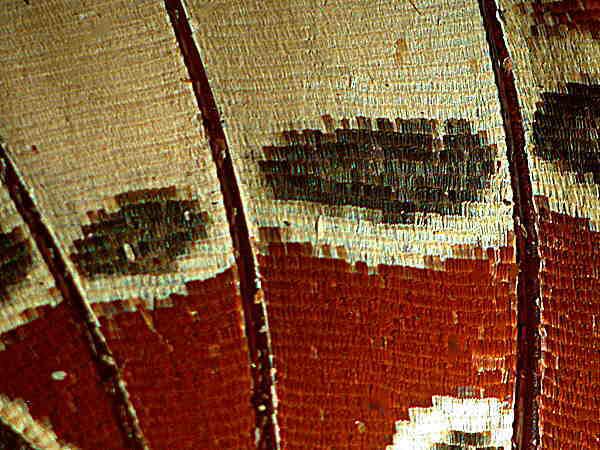
A portion of the wing of the African butterfly Charax brutus
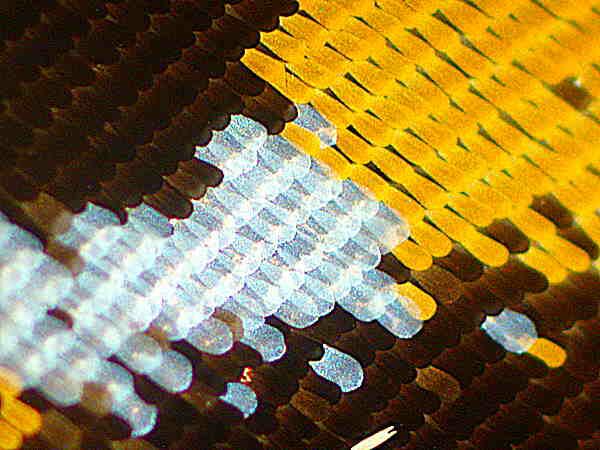
A segment of a wing of another African butterfly where the individual scales are readily discernible
Another much easier kind of slide can be made which is nonetheless interesting and pleasing. A strew slide of the scales can be made by scraping the wing.
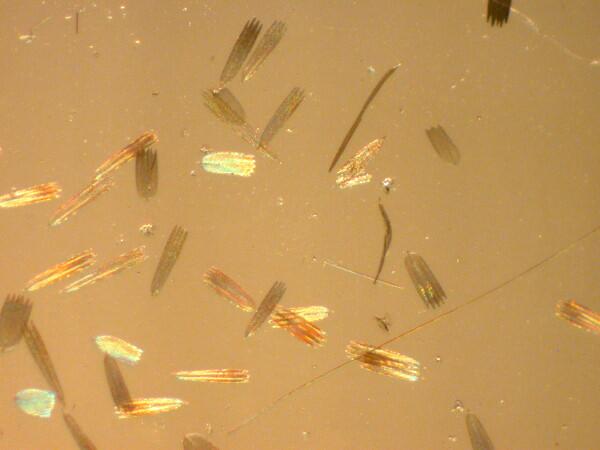
An individual scale viewed with polarized light
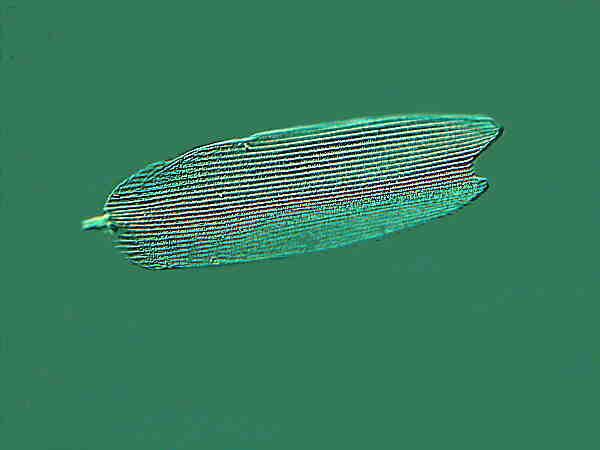
July
Wrapping Paper: Christmas in July
Last year, at Christmas, I got rather intrigued by the variety of designs and types of gift wrapping papers and I cut some samples and saved them to look at under the microscope. (Everything is fodder for the pathologically curious microscopist!) Virtually all of us have seen the slide in the “basic, standard, beginner’s” set of microscope slides of a piece of paper with the typed letter “e”----boring!!! Some of the wrapping papers are quite pleasing under the microscope. Both my wife and her mother were complaining about some sort of plasticized paper, which I freely admit is wretched wrap, but interesting to look at.
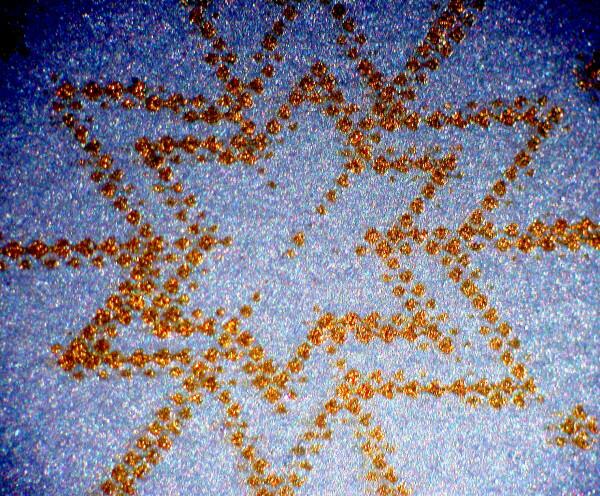
The beauty of these papers as slide materials is they are so easy to mount and again if you get a creative urge you can cut pieces so as to make pattered arrangements.
August
Dried Flowers
T.S. Eliot thought that April was the cruelest month, but I’ve always hated August. As a consequence, to escape heat and the doldrums, I tend to transport myself mentally back to an era, which admittedly I romanticize–the Victorian period in England–and fantasize about youthful love and the pressing of flowers in large, musty, old mind-numbingly dull books. Pressed flowers express a certain sad joy–recollections of the past and vain hope for the future.
Since these gifts will be for August, you will have plenty of time to make yourself some plant presses and place a nice selection of flowers, leaves, and ferns in them to dry thoroughly before you need them. Wildflowers make especially nice subjects. I’m sure you’ve all seen framed wildflower pictures; well, here’s an opportunity to try something like that on a micro-scale.
September
Feathers
As Emily Dickinson tells us “Hope is the thing with feathers”, so we can perhaps generate some colorful micro-hopes. During the late spring, summer, and early autumn when birds are frequently squabbling over food and territory, you can often find feathers around your yard, especially if you put up some bird feeders. It is, however, not advisable to handle dead birds which not only have parasites, but can carry the West Nile virus which can cause a nasty, sometimes fatal, infection. A local craft store can almost always be counted on to have a variety of feathers and stores that handle fishing tackle often have feathers for fly tying. If these sources fail, there is always the Internet. Do purchase a couple of peacock feathers. Under the microscope, they are a radiant marvel not to be missed and photographs don’t really do them justice.
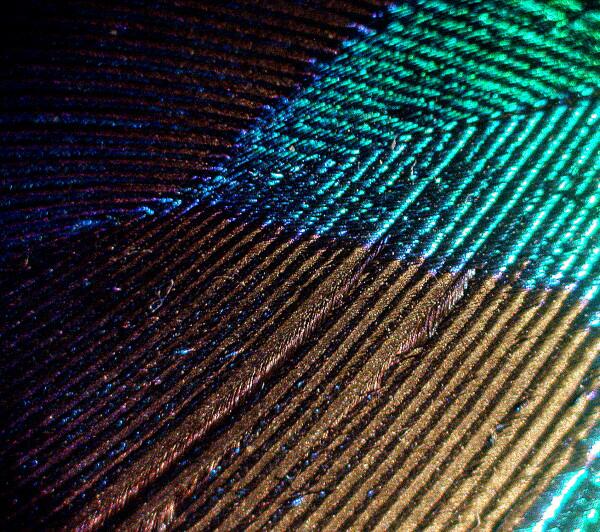
Parrot feathers are also well worth investigation. However, some feathers that look rather drab to the naked eye, prove to be splendid under magnification.
October
Autumn Leaves
If you live in a climate that has 4 seasons and real trees–unlike Los Angeles where my wife and I lived for 5 years–then during autumn, you can collect an impressive array of leaves with dozens of subtle color variations–many shades of green, yellows, reds, oranges, and browns. Select specimens in which the vein patterns are visible or, if necessary, let them decay for a bit in a dish of water. You can make up slides from a single leaf or cut sections of several different colors.
November
Insect Parts
In many parts of the world, insects can be found year around. This year, even in our rather challenging climate, although we are well into November, we have had an amazing attack of houseflies and gnats. (The little coils of sticky flypaper which I have put up have proved a goldmine of specimens.) Insects provide an astonishing variety of unusual structures from feathery antennae to mouth parts that look like they belong to some creature in a sci-fi movie.
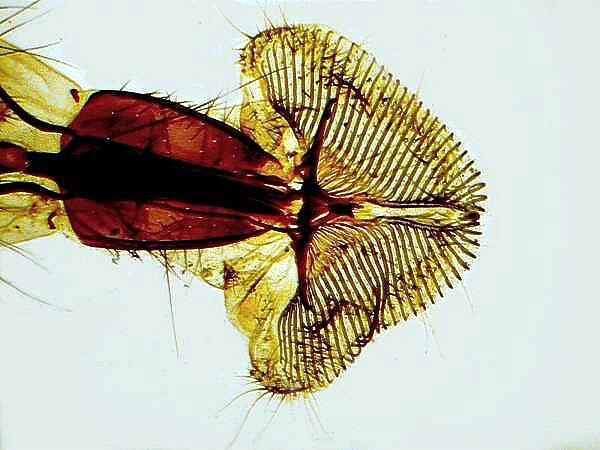
Here we have the elaborate mouth parts of a blowfly
The legs of certain bees have pouches for collecting pollen, some ants have organs for spraying formic acid at attackers, the stings of wasps and bees are like miniature swords, and the wings–the wings are miniature works of art with elaborate patterns of venation.
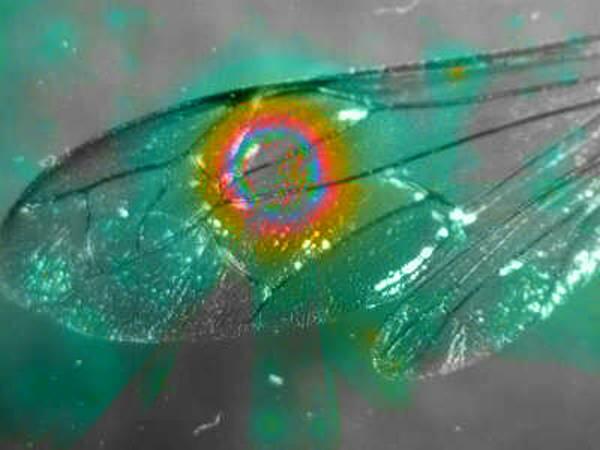
Insects are glorious in their elaborately diverse morphology and their evolutionary solutions to extraordinary environmental challenges. Just watch a dragonfly hover in mid-air and then suddenly swoop to capture and devour a mosquito (Three Cheers!) or even more astounding, mate in mid-air. Insects can also be extraordinary nuisances and even deadly dangers to us when they harbor certain viral, bacterial, and protozoan organisms. In this respect, they are stark reminders of Nature’s utter indifference to our welfare.
December
Fish Scales
I hope you were farsighted enough last summer to freeze some fish both for meals and for scales or at least to scrape off some scales and preserve them in alcohol before having a piscine repast. Fish scales are surprising and delightful objects under a microscope and they show considerable diversity. In some case, it seems odd to even refer to certain of these structures as scales. In the porcupine fish, they are more like spines.
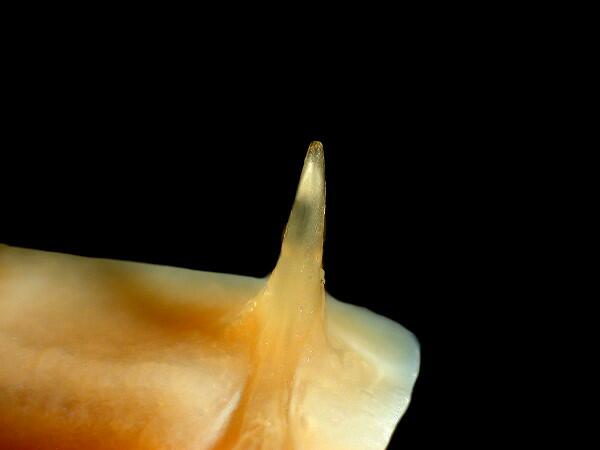
Extracting these spines, it became clear to me why these fish have few natural predators. I had to use bone shears to cut through the skin and extremely sharp micro-scalpels to finally remove the tissue. As you can see the one here is still embedded in a block of tissue and there are 3 rays at the bottom which form a sort of platform for the spine.
And, in the batfish, they are more like small coral formations embedded just under the skin.
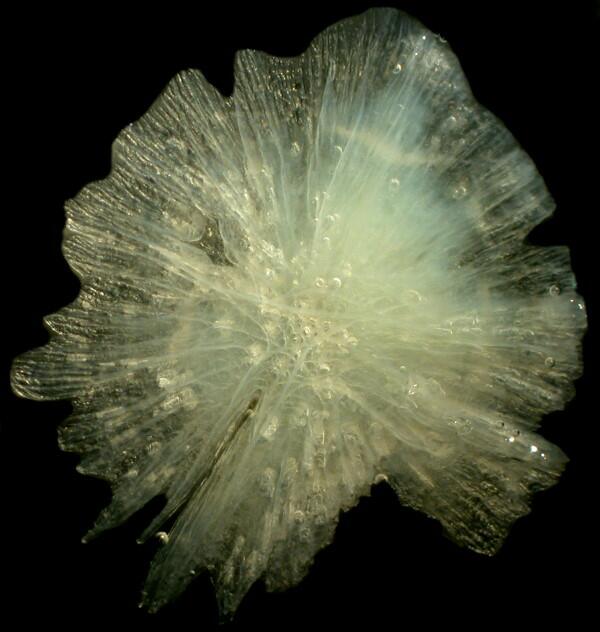
Sharks have what are called placoid scales which give their skin a very rough texture.
However, the most common type is a flattened disk with growth rings and there are 2 forms, cycloid (smooth-edged) and ctenoid tooth-edged), which are splendid under polarized light.
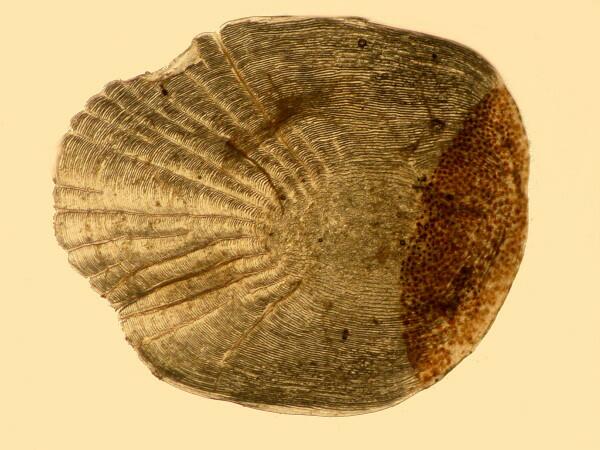
A typical cycloid scale
Clearly, I am going to have write a separate essay on scales; I got quite intrigued by them writing this article.
So, now we have our schedule for a year’s worth of objects for the Natural History Club. The final consideration is the issue of what to do with the large quantity of funds which will accumulate as profits.
3) Guidelines
a) No gambling and by that I mean No Investing in the Stock Market!
b) Provide food, medicine, and shelter for the poorest of the poor. Medicine includes contraceptives and abortions. How can any religious leader tell the poor who can barely (or not at all) feed themselves to be fruitful and multiply. In my book, that has to be one of the greatest, most pernicious sins of all time, permeated with hypocrisy and ultimately utterly undermining the value of an individual human life. At this point, I am tempted to launch a verbal tantrum about overpopulation, but since it’s the holiday season, I shall refrain.
I will simply observe as a final comment that whatever profits there are will quickly disappear trying to help just some of those who are most desperately in need. That is a sad reality, but it is also a profoundly positive effort for it would show that some of us care enough to try to counteract the outrageous greed that has overtaken both “developed’ and “developing” countries throughout the world.
End of Sermon
All comments to the author Richard Howey are welcomed.
Editor's note: Visit Richard Howey's new website at http://rhowey.googlepages.com/home where he plans to share aspects of his wide interests.
Microscopy UK Front
Page
Micscape
Magazine
Article
Library
Please report any Web problems or offer general comments to the Micscape Editor .
Micscape is the on-line monthly magazine of the Microscopy UK website at Microscopy-UK .